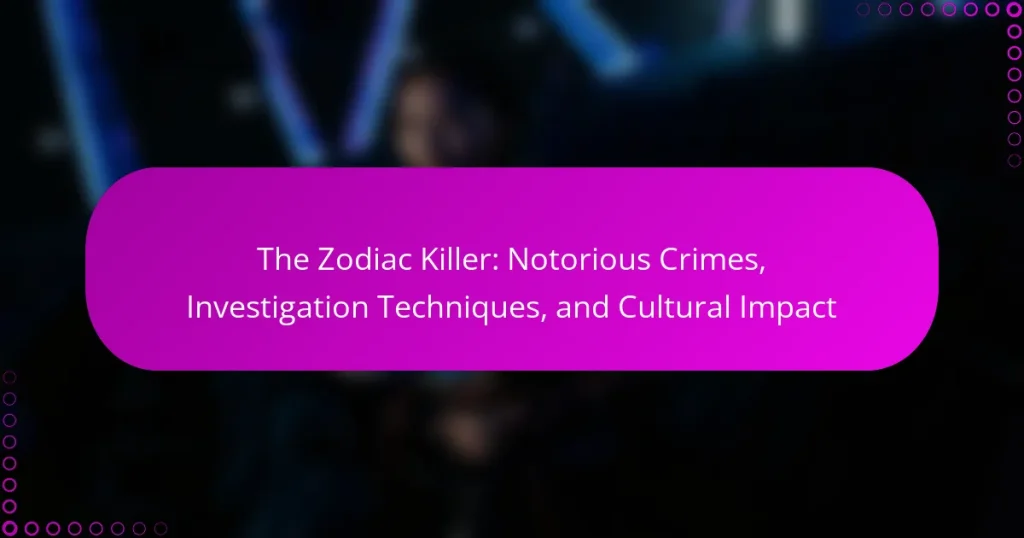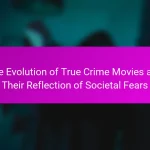The Zodiac Killer is an unidentified serial killer responsible for at least five murders in Northern California during the late 1960s and early 1970s. This case is notable for the killer’s use of taunting letters and cryptograms sent to local newspapers, containing details about the murders that were not publicly known. Despite extensive investigations utilizing forensic analysis, witness interviews, and cryptography, the identity of the Zodiac Killer remains unknown. The case has significantly impacted American criminal history and popular culture, inspiring numerous films, books, and discussions surrounding criminal psychology and law enforcement techniques. The enduring fascination with the Zodiac Killer illustrates society’s intrigue with unsolved mysteries and the true crime genre.

What is the Zodiac Killer?
The Zodiac Killer is an unidentified serial killer who operated in Northern California during the late 1960s and early 1970s. This individual is known for committing at least five murders between 1968 and 1969. The killer gained notoriety for sending taunting letters and cryptograms to local newspapers. These communications often included details about the murders that were not publicly known. The Zodiac Killer’s identity remains unknown despite extensive investigations. Various suspects have been proposed over the years, but none have been definitively proven to be the killer. The case has become a significant part of American criminal history and pop culture. It continues to attract interest and speculation among true crime enthusiasts and investigators.
What are the notorious crimes attributed to the Zodiac Killer?
The Zodiac Killer is attributed to several notorious crimes, primarily consisting of a series of murders in Northern California during the late 1960s and early 1970s. The confirmed victims include high school students Betty Lou Jensen and David Faraday, who were shot on December 20, 1968. Darlene Ferrin and Michael Mageau were attacked on July 4, 1969, with Ferrin killed and Mageau injured. The Zodiac Killer also murdered Cecelia Shepard and Bryan Hartnell on September 27, 1969, near Lake Berryessa. Hartnell survived the attack. The killer is also linked to the murder of 29-year-old cab driver Paul Stine in San Francisco on October 11, 1969. These crimes were marked by the killer’s taunting letters sent to newspapers, which contained cryptograms and threats, further solidifying his notoriety.
How did the Zodiac Killer’s crimes unfold over time?
The Zodiac Killer’s crimes unfolded between 1968 and 1969 in Northern California. The first confirmed murder occurred on December 20, 1968, when high school students Betty Lou Jensen and David Faraday were shot near Vallejo. The second attack took place on July 4, 1969, when Darlene Ferrin and Michael Mageau were shot in a parked car, with Ferrin dying and Mageau surviving.
The Zodiac Killer sent taunting letters to local newspapers, claiming responsibility for these murders. He included ciphers, some of which remain unsolved. On July 31, 1969, the killer murdered a third victim, 29-year-old Kathleen Johns, who was abducted and later escaped.
The killer’s last confirmed murder occurred on July 4, 1969, when he killed 22-year-old Bryan Hartnell and 20-year-old Cecelia Shepard at Lake Berryessa. He approached them wearing a hood with a symbol and used a knife.
The Zodiac’s final confirmed crime was the murder of 28-year-old Paul Stine on October 11, 1969, in San Francisco. This series of murders created widespread panic and led to an extensive investigation. The Zodiac Killer remains unidentified, and his crimes are still subject to ongoing research.
What were the specific locations of the Zodiac Killer’s attacks?
The Zodiac Killer’s attacks occurred in Northern California. Specific locations include Lake Berryessa, where two victims were attacked in 1968. Another site was the Blue Rock Springs Park in Vallejo, where two teenagers were shot. The first confirmed murder took place in December 1968 in the area of Vallejo. The Zodiac also claimed responsibility for the murder of a cab driver in San Francisco in 1969. Each of these locations is linked to documented incidents attributed to the Zodiac Killer.
What makes the Zodiac Killer a subject of fascination?
The Zodiac Killer is a subject of fascination due to the mystery surrounding his identity and crimes. He operated in the late 1960s and early 1970s in Northern California. The killer taunted law enforcement and the media with cryptic letters and ciphers. He claimed responsibility for several murders, but only five are confirmed. The lack of resolution in the case adds to the intrigue. Numerous theories and suspects have emerged over the years. The Zodiac’s ability to evade capture has led to extensive media coverage. This case has inspired books, films, and documentaries, further embedding it in popular culture.
Why did the Zodiac Killer’s case gain so much media attention?
The Zodiac Killer’s case gained significant media attention due to its mysterious nature and brutal crimes. The killer taunted law enforcement and the press with letters and cryptograms. This created an atmosphere of fear and intrigue among the public. The case involved multiple unsolved murders across Northern California in the late 1960s. The killer’s ability to evade capture fueled speculation and fascination. High-profile media coverage amplified public interest and concern. The Zodiac’s cryptic messages became a cultural phenomenon, inspiring numerous books and films. The combination of unsolved crimes, public fear, and media engagement kept the case in the spotlight for decades.
How has the Zodiac Killer influenced popular culture?
The Zodiac Killer has significantly influenced popular culture through various media representations. Numerous films, documentaries, and books have explored his crimes and persona. The 2007 film “Zodiac,” directed by David Fincher, brought renewed attention to the case. It highlighted the obsession of journalists and law enforcement in solving the mystery. Additionally, the Zodiac’s cryptic letters and ciphers have inspired puzzle enthusiasts and artists. The killer’s enigmatic nature has led to numerous conspiracy theories and discussions in online forums. Pop culture references often depict him as a symbol of unsolved mysteries and fear. His influence continues to resonate in true crime narratives and discussions about serial killers.

What investigation techniques were used in the Zodiac Killer case?
The investigation techniques used in the Zodiac Killer case included forensic analysis, witness interviews, and cryptography. Forensic analysis involved examining crime scenes for physical evidence such as fingerprints and ballistics. Witness interviews were conducted to gather descriptions of the suspect and details of the incidents. Cryptography played a crucial role as the Zodiac Killer sent coded messages to the media and police. These codes were analyzed by experts and amateur cryptographers, leading to the decoding of some messages. The combination of these techniques aimed to identify and apprehend the killer. Despite extensive investigations, the case remains unsolved, highlighting the challenges faced by law enforcement.
How did law enforcement approach the investigation of the Zodiac Killer?
Law enforcement approached the investigation of the Zodiac Killer through a combination of forensic analysis, public appeals, and inter-agency collaboration. They meticulously gathered evidence from crime scenes, focusing on ballistics and fingerprints. Investigators also analyzed letters sent by the Zodiac to the media and police, seeking clues in the cryptograms. Public involvement was encouraged, with law enforcement urging citizens to report any suspicious activity. The case involved multiple police departments due to the geographic spread of the crimes, necessitating coordination among agencies. Despite extensive efforts, the investigation faced challenges due to the lack of conclusive evidence and the killer’s ability to evade capture. The Zodiac Killer remains unidentified, highlighting the complexities of the case.
What forensic methods were employed during the investigation?
The forensic methods employed during the investigation included fingerprint analysis, ballistic analysis, and DNA profiling. Fingerprint analysis was crucial in identifying potential suspects. Investigators examined crime scenes for latent prints. Ballistic analysis involved matching bullets to firearms. This method helped link crimes to the same weapon. DNA profiling emerged later in investigations. It provided a way to identify suspects through biological evidence. These methods collectively enhanced the investigation’s accuracy and effectiveness.
How did the use of media impact the investigation’s progress?
The use of media significantly impacted the investigation’s progress by increasing public awareness and engagement. Media coverage brought attention to the Zodiac Killer’s crimes, prompting more eyewitnesses to come forward. As a result, law enforcement received crucial tips that may not have surfaced otherwise. The Zodiac Killer even communicated with the media, sending letters that included ciphers. These letters generated widespread interest and analysis, leading to collaborative efforts among amateur sleuths and professionals. This collaboration enhanced the investigation’s visibility and urgency. Overall, media played a pivotal role in shaping the investigation’s trajectory and public involvement.
What challenges did investigators face in solving the Zodiac Killer case?
Investigators faced numerous challenges in solving the Zodiac Killer case. The killer taunted law enforcement with cryptic letters and ciphers. These communications created confusion and required extensive analysis. Limited forensic technology hindered the ability to gather definitive evidence. Witness accounts varied significantly, complicating the identification of suspects. The killer’s ability to evade capture during multiple attacks showcased law enforcement’s limitations. Jurisdictional issues arose as crimes occurred across different counties. Public interest and media attention led to misinformation and speculation. These factors collectively prolonged the investigation and made resolution difficult.
How did the lack of technology affect the investigation?
The lack of technology significantly hindered the investigation into the Zodiac Killer. Investigators relied on manual methods for evidence collection and analysis. Forensic techniques were limited, making it difficult to analyze fingerprints and DNA. Communication between law enforcement agencies was slow and inefficient. They often worked in silos without real-time data sharing. The absence of digital databases made it challenging to track suspects and leads. As a result, many potential clues were overlooked or lost. This technological gap allowed the Zodiac Killer to evade capture for an extended period.
What role did public involvement play in the investigation?
Public involvement was crucial in the investigation of the Zodiac Killer. It helped generate leads and gather information from the community. Citizens provided tips, reported sightings, and shared personal experiences related to the crimes. This grassroots engagement facilitated the dissemination of information through media coverage. The extensive media attention encouraged more people to come forward with relevant details. Investigators often relied on public assistance to solve cases. The collaboration between law enforcement and the public was vital in piecing together the killer’s identity. Overall, public involvement significantly influenced the investigation’s progress and direction.

What is the cultural impact of the Zodiac Killer?
The Zodiac Killer has had a profound cultural impact since the late 1960s. This serial killer’s unsolved crimes have inspired numerous films, books, and documentaries. The public fascination with the Zodiac Killer reflects society’s intrigue with unsolved mysteries. The case has contributed to the true crime genre’s popularity in media. Iconic symbols, such as the Zodiac’s cryptograms, have become cultural references. The killer’s taunting letters to the press have influenced how media covers crime stories. The Zodiac Killer has also sparked discussions on criminal psychology and law enforcement techniques. Overall, the cultural impact is evident in the ongoing interest and analysis of the case.
How has the Zodiac Killer been represented in film and literature?
The Zodiac Killer has been represented in various films and literature, often highlighting the mystery surrounding the case. Notable films include “Zodiac” (2007), directed by David Fincher, which depicts the investigation into the killer’s identity. The film is based on the book “Zodiac” by Robert Graysmith, which explores the killer’s letters and the impact on society.
Literature also includes works like “The Most Dangerous Animal of All” by Gary L. Stewart, which presents a personal investigation into the case. These representations often emphasize themes of obsession, fear, and the media’s role in sensationalizing the murders. The Zodiac Killer’s cryptic letters and ciphers have further inspired numerous documentaries and novels, cementing his status as a cultural icon of true crime.
What are some notable films and books inspired by the Zodiac Killer?
Notable films and books inspired by the Zodiac Killer include “Zodiac,” directed by David Fincher. This film, released in 2007, explores the investigation of the Zodiac murders. Another significant work is “The Zodiac” by Robert Graysmith, published in 1986. This book provides an in-depth look at the killer’s identity and the police investigation. “Zodiac Unmasked,” also by Graysmith, published in 2002, offers further analysis and theories about the case. Additionally, the graphic novel “Zodiac” by the artist and writer, is inspired by the killer’s story. These works have contributed to the ongoing fascination and cultural impact of the Zodiac Killer.
How do these representations shape public perception of the case?
Representations of the Zodiac Killer shape public perception by creating a narrative that emphasizes mystery and intrigue. Media portrayals often highlight the killer’s elusiveness and intelligence. This focus can lead to fascination and fear among the public. The sensationalized coverage can distort perceptions of the actual events. For instance, films and documentaries may exaggerate details for dramatic effect. Such representations can influence how people view law enforcement’s effectiveness in solving the case. Additionally, the portrayal of the Zodiac Killer as a cultural icon can romanticize violence. This can desensitize audiences to the real-life impact of the crimes on victims and communities.
What lessons can be learned from the Zodiac Killer’s case?
The Zodiac Killer’s case teaches several important lessons about criminal investigation and public communication. First, it highlights the challenges of forensic technology in the 1960s. Limited resources hindered the ability to analyze evidence effectively. Second, the case underscores the significance of public engagement in investigations. The Zodiac Killer taunted law enforcement and the media, which led to widespread public fascination. Third, it illustrates the importance of inter-agency collaboration. Different police departments struggled to share information, which delayed progress. Finally, the case emphasizes the need for ongoing advancements in forensic science. Modern techniques could potentially yield new insights into cold cases like this one.
How can modern investigations benefit from the Zodiac Killer case?
Modern investigations can benefit from the Zodiac Killer case by analyzing historical forensic techniques. The case highlights the importance of DNA evidence, which was not available at the time of the murders. Advances in DNA analysis now allow for re-examination of evidence collected decades ago. Investigators can apply modern profiling techniques to understand the killer’s behavior better. The Zodiac case also serves as a case study in cold case resolution strategies. Law enforcement agencies can learn from the collaborative efforts that were required to investigate the case. Additionally, the Zodiac Killer’s use of media can inform current strategies for public engagement in investigations. Overall, the case offers valuable lessons in investigative practices and the evolution of forensic science.
What best practices can be derived for handling cold cases?
Best practices for handling cold cases include thorough documentation, regular review, and updated investigative techniques. Thorough documentation ensures all evidence and leads are recorded comprehensively. Regular review allows investigators to reassess the case with fresh perspectives. Updated investigative techniques involve using modern forensic technology, such as DNA analysis, which has solved many cold cases. Collaboration with specialized units or cold case squads can bring new insights. Engaging with the community for tips can also yield valuable information. These practices enhance the chances of resolving cold cases effectively.
The Zodiac Killer is an unidentified serial killer responsible for at least five murders in Northern California during the late 1960s and early 1970s, known for sending taunting letters and cryptograms to the media. The article explores the notorious crimes attributed to the Zodiac Killer, including the specific locations and timeline of the attacks. It also examines the investigation techniques employed, the challenges faced by law enforcement, and the significant media attention the case garnered. Furthermore, the article discusses the cultural impact of the Zodiac Killer, including representations in film and literature, and the lessons learned from this enduring criminal mystery.


